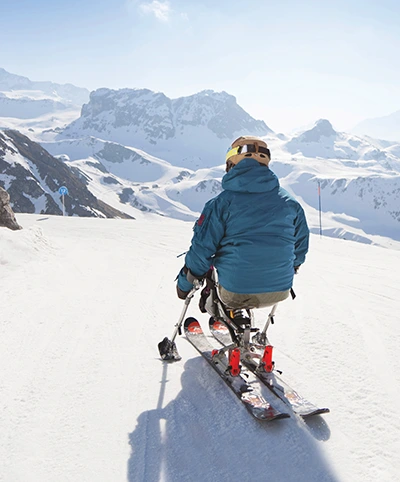
Winter sports have produced some of the limb-loss community’s most famous athletes. From Amy Purdy to Oksana Masters, Monster Mike Schultz, and the USA’s juggernaut sled hockey team, lots of amputee competitors have made their mark on snow and ice.
But those are exceptional individuals. If you’re a typical person, it takes more effort to stay active in the cold-weather months than it does in spring, summer, and fall. You can’t just step outside for a run, a bike ride, or a hike. Most winter sports require specialized (and expensive) equipment, and you might have to drive (or fly) many miles to get to a facility where you can participate. There are fewer hours of daylight to work with, and everything is contingent on decent weather. No wonder the lure of the couch and a warm fire feels so powerful.
These deterrents are enough to keep most able-bodied people in hibernation mode. Overcoming them when you’re missing one or more limbs can be even more challenging. But it’s just as important to stretch your muscles and engage your mind during winter as in any other season. Here are some low-threshold ways that all amputees—even non-medal contenders—can keep active until the spring thaw.
SLED HOCKEY
Why to play: If you enjoy speed and camaraderie, you’ll love this fast-growing sport. It’s fairly easy to learn, and the number of adaptive rinks around the country is on the rise.
How to get started: Begin at USA Hockey (usahockey.com/disabledhockey) for information about where to play in your area. Move United (moveunitedsport.org) is another excellent resource; more than 20 of its chapters sponsor sled-hockey programs.
CURLING
Why to participate: Few winter sports are as easy to pick up. Curling is accessible to people of all fitness levels, and it doesn’t require expensive clothing or gear. You can play with a prosthesis or with a wheelchair.
How to get started: Visit USA Curling’s website and hit the “Start Curling” tab (usacurling.org/find-a-club). The interactive map allows you not only to search by location but also to find clubs with accessible facilities and programs.
SNOWMOBILING
Why to participate: If you can sit, you can ride—and there’s no easier way to get out on the trail for spectacular snow-covered scenery. Since the accelerator and brakes are on the vehicle’s handlebars, upper-limb amputees typically use adaptive devices similar to the ones bicyclists and motorcyclists use.
How to get started: Beginning snowmobilers should start with a rental outfitter. Some offer guided outings; others allow you to rent by the hour and explore on your own. Find a state-by-state directory at snowmobilers.org/snowmobile-associations.
STAND-UP HOCKEY
Why to play: Adaptive hockey sticks make this a great option for upper-limb amputees, and skate-equipped prosthetic legs make it increasingly viable for lower-limb amputees.
How to get started: Once again, USA Hockey (usahockey.com/disabledhockey) is the best place to begin.
Winter Starts Now
Looking for a little snowsports inspiration? Check out Winter Starts Now, a 2021 feature-length movie from legendary ski documentarian Warren Miller. The 95-minute film captures the first-ever adaptive descent of North America’s tallest mountain, Denali, by amputee carvers Pete McAfee and Vasu Sojitra. There’s also some stunning stunt footage starring two-time Paralympic snowboarder Noah Elliott. You can stream it at Outside Online.




